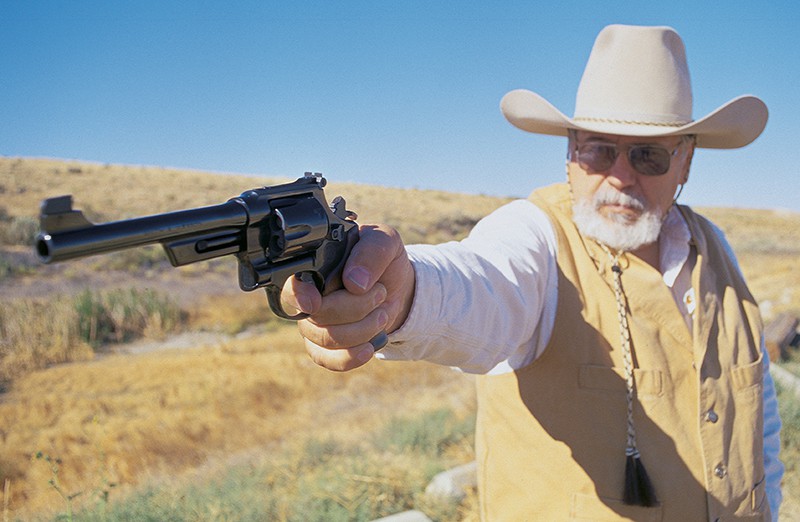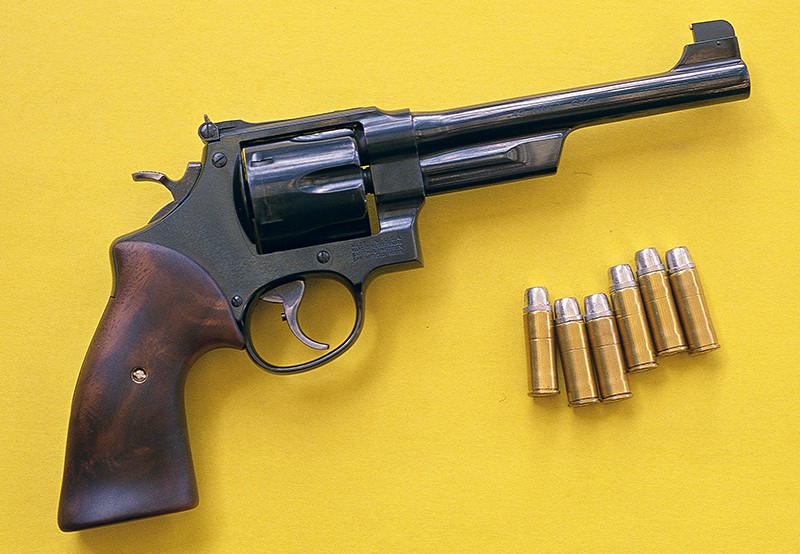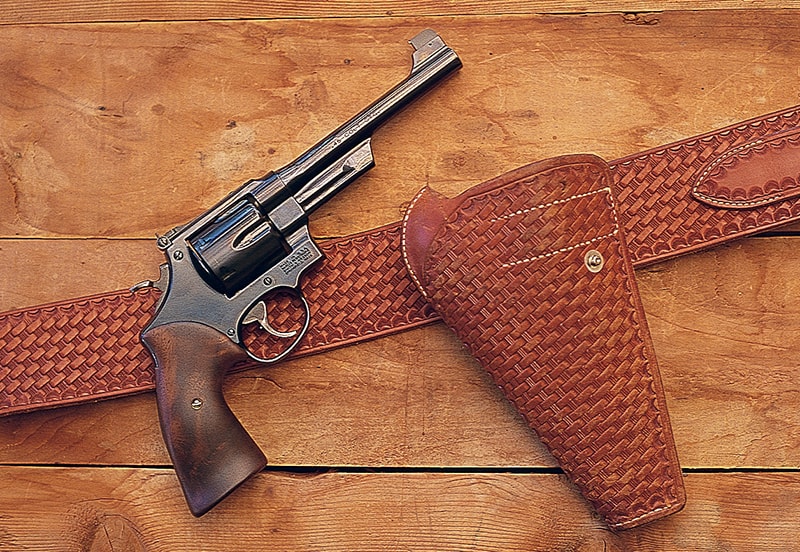Smith & Wesson
Model HEG .45 Colt
From The S&W Performance Center
Smith & Wesson’s first double action sixguns appeared in 1881 with the introduction of the topbreak .44 Double Action First Model. As with their earlier single action models, these six-shot revolvers were hinged at the front of the frame with a locking latch at the rear of the top-strap above the hammer.
When the latch was opened and the barrel allowed to tip forward, cartridges were automatically ejected from the cylinder. The shooter could then reload, return the barrel to its upright position, and be ready to shoot all in a matter of a very few seconds. A most efficient design — but not overly strong.
Stronger And Better
In 1907, Smith & Wesson redesigned their DA big bore sixgun to a solid frame with swing-out cylinder. It was not as fast to operate as the top break design but was significantly stronger, eventually being chambered for the .357, .44, and .41 Magnums. That first S&W solid frame double action revolver — which would become the sixgun by which all subsequent DA revolvers would be judged — was the .44 Hand Ejector First Model, or as it is most affectionately known, the Triple-Lock.
This first .44 Special would be manufactured from 1907 to 1915 with a total of 15,375 being made in both adjustable- and fixed-sighted versions. Barrel lengths offered were 4-, 5-, 6 1⁄2- and 7 1⁄2-inches. As with all S&W DA revolvers manufactured since, this First Model Hand Ejector locked up at the rear of the cylinder and the front of the ejector rod.
This arrangement actually began with the .38 Military & Police Second Model of 1902. However, this first .44 Special was unique in that it boasted a third locking feature. The crane locked into the frame with a superbly crafted third lock that was made without the advantage (disadvantage?) of modern machinery. The Triple-Lock was also the first double action Smith & Wesson to have an enclosed or shrouded ejector rod.
Stable Of Memorable Sixguns
Many sixgunners would say this was the finest Smith & Wesson ever built. Perhaps, and only perhaps, it was challenged by the pre-War .357 Registered Magnums and/or the pre-Model 29 .44 Magnums of 1956. Unfortunately, the only thing that we can count on never changing is the fact that there will always be change. Thus in 1915, the Triple-Lock changed dramatically to be able to lower the retail price by two dollars.
The .44 Hand Ejector Second Model arrived without the third locking feature and the enclosed ejector rod was now gone. All for $2! This model would become the .45 ACP Hand Ejector U.S. Service Model two years later.
The Hand Ejector series continued to evolve and with the return of the enclosed ejector rod became the Model 1926. Other evolutionary adaptations were the .38-44 Heavy Duty and Outdoorsman Models of 1930, which later became the .357 Magnum in 1935. The big N-frame got back on the .44 track with the Fourth Model 1950 Target .44 Special, which then became the .44 Magnum in 1956.
Along the way a few of the four models of hand ejectors can be found in other chamberings such as the First Model in .44 Russian, .44-40, .455, .38-40, and .45 Colt; Second Model, .45 Colt, .44-40, and .38-40; Third Model, .44-40 and .45 Colt; and the Fourth Model, .45 ACP and .45 Colt. Most of these are relatively rare and hard to find.
All of these models were offered in basic blue, often Smith & Wesson’s beautiful Bright Blue, and some fixed sighted models can be found finished with nickel plating. They are the most beautiful double action revolvers ever offered. However, seventy years after the introduction of the Triple-Lock, the road to Sixgun Perfection took a major detour.
End Of An Era
First stainless-steel began to appear with the .44 Magnum Model 629. The old ways were disappearing. Then came heavy, full-underlug barrels and the old ways faded even more. Finally came round butted grip frames on all Smith & Wesson sixguns and the old ways were gone!
Yes, I realize that I am highly biased and opinionated when it comes to what a double action revolver should look like, and I definitely believe in standard barrels, square butts, and Bright Blue finishes. I will not argue with you if you prefer the new ways nor will I change my mind about the old ways.
When I visit gun shops, or walk the aisles of gun shows, I seldom give newly manufactured sixguns a second look. Instead, I’m looking for the sixguns of the old ways. Yes, I realize that today we are privileged to have what are probably the best built sixguns ever offered. Certainly they are the strongest and most accurate. It is simply that they do not stir the depths of my soul like the sixguns of the old ways. And at my age my soul and spirit need and deserve of great deal of stirring.
The wise man said, “you can never go home again.” If you have ever visited places of your childhood you understand exactly what he meant. We can’t go back. Everything changes. But once in awhile, just once in awhile mind you, something happens to open a portal to the past and it is our great loss if we don’t go through.
Smith & Wesson has been opening a lot of portals to the past lately with special sixguns offered by the Performance Center. In 2001 they reached all the way back to 1870 to bring out the Schofield Model 2000. In 2002 they moved ahead to 1908 to return us to the First Model Hand Ejector.
My soul has been stirred and my spirit is soaring with the advent of the 45 HEG from the Performance Center. HEG stands for Hand Ejector Gold and under the grand numbering system of S&W revolvers this is Model 25-10. In this the age of endless heavy-barreled, round-butted, stainless-steel revolvers, suddenly we have something that is almost completely different.
Afraid Of Excellence?
It has long been my contention that gunmakers somehow get scared or nervous when they get to close to perfection. Cases in point: In 1955, Ruger totally modernized the Colt SAA by adding coil springs, a virtually unbreakable lockwork, and a flat-topped frame with adjustable sights. Ruger wisely chambered it in .357 Magnum quickly followed by a .44 Magnum, and then — having almost arrived at sixgun perfection — fitted it with an aluminum alloy grip frame.
Colt countered in 1962 with the most beautiful single action factory produced sixgun of all time, the New Frontier, but refused to update the lockwork and then equipped it with second-rate stocks with all the grace of muddy fence posts.
Close Look At The HEG
Now Smith & Wesson has come very close to Sixgun Perfection. With all apologies to S&W for my biases, I will still say this is one beautiful sixgun. Let’s look at it together, first highlighting what they did that was perfectly right.
The barrel is marked “.45 COLT CTG.” thus the caliber is .45 Colt. This is a great surprise, as one might expect it to be chambered for .44 Special. Perhaps this should be no surprise, as thanks to Cowboy Action Shooting, the .45 Colt is probably the most popular big bore sixgun cartridge today.
The finish is reminiscent of the old S&W Bright Blue. The barrel is the slim profile found on pre-war revolvers from Smith & Wesson, with the front ramp integral with the barrel. Sights are an adjustable rear with a gold bead post front sight, the standard trigger is smooth, while the hammer has a unique tear drop shape. All in all a sixgun that feels nice in the hand and is pleasant to look upon.
Not Your Father's Triple-Lock
My personal bias and appreciation for the old S&Ws motivate me to note the following. Barrel length is 6 inches instead of the standard 6 1⁄2 inches of pre-war days, and the grip frame is round-butt style instead of the original square butt. For some odd reason, while there is a third locking feature at the front of the cylinder, the traditional locking plunger at the end of the ejector rod housing is gone.
Due to modern manufacturing techniques the old style firing-pin-on-the-hammer has been replaced by a frame mounted firing pin. Additionally, instead of the precisely machined crane lock which gave the Triple-Lock its name, we now have a ball detent at the front of the yoke that locks into the back of the ejector rod enclosure.
Another result of modern manufacturing is the round-butted grip frame. Smith & Wesson has compensated for this with a modern version of the old pre-war Roper stocks. They tried so hard to please me in this area but unfortunately the grips do not fit my hand, or probably it is more appropriate to say my hand does not fit this grip!
J.T.’s Stock Options
At least 40 years ago, Skeeter Skelton came up with an improved version of the Roper grip design which was eventually offered to the public in the 1980s by BearHug Grips. Since the going Home of BearHug’s Deacon Deason, these stocks have been offered by BluMagnum.
For initial testing, I borrowed the exotic wood Skeeter Skelton grips from my S&W Mountain Gun for use on the .45 Hand Ejector. Later, Tedd Adamovich of BluMagnum provided me with a set of round-butt-to-square butt Skeeter Skelton stocks crafted in fancy walnut.
I can live with the 6-inch barrel. I even have a vintage Berns-Martin breakfront holster found in New Mexico two years ago which fits a large frame 6-inch S&W. The lack of a third locking feature does not bother me at all nor does the frame mounted firing pin. So with the round butt grip frame situation taken care of, you might say I am 99.9 percent pleased with the 45HEG.
Common Sense Loads
Although some .45 Colt chambered sixguns are capable of handling heavy-duty .45 Colt loads in excess of 30,000 psi, I have no intent to nor do I see any reason to push this new-old sixgun. This is a standard sixgun, weighing 38 ounces with the BluMagnum stocks installed. It’s best suited for, and most enjoyable with standard loads.
With this in mind, I gathered together some current factory .45 Colt loads as well as assembling some favorite handloads. The single action trigger pull measured 4 pounds, 2 ounces on my RCBS Premium Trigger Pull Scale.
In testing, all groups were fired at 25 yards from a sandbag rest. I quickly found that this revolver could be very selective as to which loads it liked, with groups ranging from 1- to 3-inches resulting. Muzzle velocity seemed to be more important than whether bullets were cast or jacketed, with the best results usually coming from loads in the 1,000 fps range.
My everyday working load for this sixgun is the RCBS No. 45-270 SWC over 18.5 grains of H4227 for 900 fps, and groups just slightly over 1-inch. For a jacketed bullet load I can be happy with the Hornady 250, Sierra 240, or Speer 260 grain JHP over 9.4 grains of Unique for the same 900 fps muzzle velocity and equally good groups.
Pleasant-Shootin’ Pistol
Shooting this “old” sixgun was nothing but pure pleasure with minimum felt recoil providing a welcome diversion from many of the big bore sixguns I normally fire in the course of my work. The .45 Colt has always had a reputation for combining excellent stopping power with relatively little recoil. However, even at 900 fps, the big flat-nosed .45s still manage to speak with great authority in most situations.
The 45HEG, or Model 25-10 has already spawned further variations on the same prewar sixgun theme, with a similar model bearing a case-colored frame and standard sized stocks on its round butt grip frame, as well as the 1917 Model chambered in .45 ACP/.45 Auto Rim. This latter variation is without the enclosed ejector rod, and features a military style lanyard ring in the bottom of the grip frame. May there be many more.
Yes, the old days and the old guns are gone for ever. It may be true that we can’t go home again, but I’m sure glad Smith & Wesson has at least brought us back to the same familiar old neighborhood.

Get More Revolver Content Every Week!
Sign up for the Wheelgun Wednesday newsletter here:








